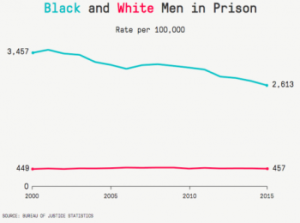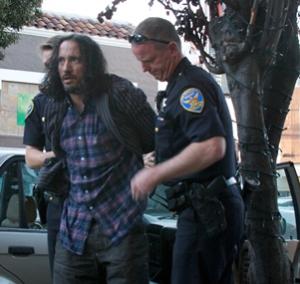It's long been a given that tremendous racial disparities plague the nation's criminal justice system. That's still true -- blacks are incarcerated at a rate five times that of whites -- but the racial disparities are decreasing, and there are a number of interesting reasons behind the trend.

When it comes to women, the numbers are even more striking. While the black female incarceration rate plummeted by nearly 50% in the first 15 years of this century, the white rate jumped by a whopping 53%.
And make no mistake: Racial disparities in incarceration rates haven't gone away. As the NAACP notes, African Americans account for only 12 percent of the US population, but 34 percent of the population in jail or prison or on parole or probation. Similarly, black children account for 32 percent of all children who are arrested and more than 50 percent of children who are charged as adults.
In and of itself, increases in the white incarceration rate isn't a good thing. The world's leaders incarcerator state needs to reduce the number of prisoner it holds, especially for nonviolent, mostly low-level offenses such as drug crimes, not just shift who the people are that it incarcerates. Still, the reduction in disparities is at least an improvement, and has come with some reduction in the numbers of minorities being imprisoned.
When it comes to drugs, the NAACP reports, African Americans use drugs in proportion to their share of the population (12.5 percent), but account for 29 percent of all drug arrests and 33 percent of state drug prisoners. Black people still bear the heaviest burden of drug law enforcement.
Still, that that 5:1 ratio for black vs. white male incarceration rates in 2015, was an 8:1 ratio 15 years earlier. Likewise, that 2:1 ration for black vs. white female incarceration rates was a 6:1 ratio in 2000.
"It's definitely optimistic news," Fordham University law professor and imprisonment trends expert John Pfaff told the Marshall Project. "But the racial disparity remains so vast that it's pretty hard to celebrate. How, exactly, do you talk about 'less horrific?'"
So what the heck is going on? These numbers challenge the standard narrative around mass incarceration, if only partially. It behooves analysts and policymakers alike to try to make sense of the changing complexion of the prison population, but that's no easy task.
"Our inability to explains it suggest how poorly we understand the mechanics behind incarceration in general," Pfaff said.
Still, the Marshall Project wanted some answers, so it did more research and interviewed more prison system experts, and here are four theories, not mutually exclusive, that try to provide them:
Crime Has Been Declining Overall
Arrests for nearly all types of crime rose into the mid-1990s, then declined dramatically, affecting African-Americans more significantly than whites since they were (and are) more likely to be arrested by police in the first place. In the first decade of the new century, arrests of black people for violent offenses dropped 22%; for whites, the decline was 11%. Since those offenses are likely to result in substantial prison sentences, this shift has likely contributed to the changing racial makeup of the prison population.

The black vs. white disparity in the prosecution of the war on drugs is notorious, and a central tenet of drug reform advocacy. But even though blacks continue to suffer drug arrests, prosecutions, and imprisonment at a far greater rate than whites, something has been happening: According to BJS statistics, the black incarceration rate for drug offenses fell by 16% between 2000 and 2009; at the same time, the number of whites going to prison for drugs jumped by nearly 27%.
This could be because the drug crises of the day, methamphetamines and heroin and prescription opioid addiction, are mainly white people drug problems. Back in the 1980s and 1990s, the drug crisisdu jour was crack cocaine, and even though crack enjoyed popularity among all races, the war on crack was waged almost entirely in black communities. The war on crack drove black incarceration rates higher then, but now cops have other priorities.
The shift in drug war targeting could also explain the dramatic narrowing of the racial gap among women prisoners, because women prisoners are disproportionately imprisoned for drug crimes.
White People Blues
Declining socioeconomic prospects for white people may also be playing a role. Beginning around 2000, whites started going to prison more often for property offenses, with the rate jumping 21% by 2009. Meanwhile, the black incarceration rate for property crimes dropped 9%.
Analysts suggest that an overall decline in life prospects for white people in recent decades may have led to an increase in criminality among that population, especially for crimes of poverty, such as property crimes. A much discussed study by economists Anne Case and Angus Deaton found that between 1998 and 2013, white Americans were experiencing spikes in rates of mortality, suicide, and alcohol and drug abuse. That's precisely when these racial shifts in imprisonment were happening.
And while blacks also faced tough times, many whites were newer to the experience of poverty, which could explain why drug use rates, property crime, and incarceration rates are all up.
Reform is More Likely in the Cities, Where More Black People Live
Since the beginning of this century, criminal justice reform has begun to put the brakes on the mass incarceration engine, but reforms haven't been uniform. They are much more likely to have occurred in more liberal states and big cities than in conservative, rural areas.
In big cities such as Los Angeles and Brooklyn, new prison admissions have plummeted thanks largely to sentencing and other criminal justice reforms. But in counties with fewer than 100,000 residents, the incarceration rate was going up even as crime went down. In fact, people from rural areas are 50% more likely to be sent to prison than city dwellers.
Even in liberal states, the impact of reforms vary geographically. After New York state repealed its draconian Rockefeller drug laws, the state reduced its prison population more than any other state in the country in the 2000s. But the shrinkage came almost entirely from heavily minority New York City, not the whiter, more rural areas of the state.
People in rural districts are now 50 percent more likely to be sent to prison than are city dwellers, as local prosecutors and judges there have largely avoided the current wave of reform. New York offers an illustrative example. It reduced its incarcerated population more than any other state during the 2000s -- but almost entirely through reductions in the far more diverse New York City, not in the whiter and more sparsely populated areas of the state.
Whatever the reason for the shrinking racial disparities in the prison population, there is a long way to go between here and a racially just criminal justice system. If current trends continue, it would still take decades for the disparities to disappear.
This work by StoptheDrugWar.org is licensed under Creative Commons Attribution-ShareAlike 4.0 International
Add new comment